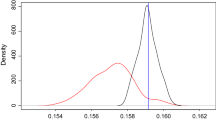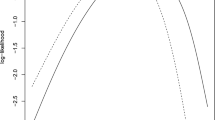Abstract
Suppose a model has parameter \(\theta =(\psi , \lambda )\), where \(\psi \) is the parameter of interest and \(\lambda \) is a nuisance parameter. The integrated likelihood method eliminates \(\lambda \) from the likelihood function \(L(\psi , \lambda )\) by integrating with respect to a weight function \(\pi (\lambda | \psi )\). The resulting integrated likelihood function \(\bar{L}(\psi )\) can be used for inference for \(\psi \). However, the analytical form for the integrated likelihood is not always available. This paper discusses 12 different approaches to computing the integrated likelihood. Some methods were originally developed for other computation purposes and they are modified to fit in the integrated likelihood framework. Methods considered include direct numerical integration methods such as Monte Carlo integration method, importance sampling, Laplace method; marginal likelihood computation methods; and methods for computing the marginal posterior density. Simulation studies and real data example are presented to evaluate and compare these methods empirically.




Similar content being viewed by others
References
Berger JO, Liseo B, Wolpert RL (1999) Integrated likelihood methods for eliminating nuisance parameters. Stat Sci 14(1):1–22
Barndorff-Nielsen O (1980) Conditionality resolutions. Biometrika 67(2):293–310
Barndorff-Nielsen O (1983) On a formula for the distribution of the maximum likelihood estimator. Biometrika 70(2):343–365
Barndorff-Nielsen OE (1995) Stable and invariant adjusted profile likelihood and directed likelihood for curved exponential models. Biometrika 82(3):489–499
Barndorff-Nielsen OE, Nielsen OEB (1989) Asymptotic techniques; for use in statistics
Bos CS (2002) A comparison of marginal likelihood computation methods. In: COMPSTAT 2002—proceedings in computational statistics, pp 111–117
Chen M-H (1994) Importance-weighted marginal bayesian posterior density estimation. J Am Stat Assoc 89:818–824
Chen M-H (2005) Bayesian computation: from posterior densities to Bayes Factors, marginal likelihoods, and posterior model probabilities. Handb Stat 25:437–457
Chib S (1995) Marginal likelihood from the Gibbs output. J Am Stat Assoc 90:1313–1321
Chib S, Greenberg E (1995) Understanding the metropolis hastings algorithm. Am Stat 49:327–335
Chib S, Jeliazkov I (2001) Marginal likelihood from the Metropolis–Hastings output. J Am Stat Assoc 96:270–281
Cox CP (1985) Interval estimates for the ratio of the means of two normal populations with variances related to the means. Biometrics 41:261–265
Cox DR, Snell EJ (1981) Applied statistics: principles and examples. Chapman and Hall, London
Gelfand AE, Smith AFM, Lee TM (1992) Bayesian analysis of constrained parameter and truncated data problems using Gibbs sampling. J Am Stat Assoc 87:523–532
Givens GH, Hoeting JA (2005) Computational statistics. Wiley, New York
Hastings WK (1970) Monte Carlo sampling methods using Markov Chains and their applications. Biometrika 57:97–109
Jensen JL (1995) Saddle point approximations. Oxford University Press, Oxford
Kalbfleisch JD, Sprott DA (1970) Application of likelihood methods to models involving large numbers of parameters (with discussion). J R Stat Soc B 32:175–208
Kass RE, Tierney L, Kadane JB (1990) Bayesian and likelihood methods in statistics and econometrics: essays in honor of George A, Barnard. Amsterdam, pp 473–488
Kass RE, Carlin BP, Gelman A, Neal RM (1998) Markov Chain Monte Carlo in practice: a roundtable discussion. Am Stat 52(2):93–100
Li Q, Racine JS (2007) Nonparametric econometrics: theory and practice. Princeton University Press, Princeton
Liseo B (1993) Elimination of nuisance parameters with reference priors. Biometrika 80:295–304
Mendoza M, ITAM RH, Angel S (2005) Inferences on the ratio of normal means and other related problems. Estadistica 57:168–169
Meng XL, Schilling S (2002) Warp Bridge sampling. J Comput Graph Stat 11(3):552–586
Meng XL, Wong WH (1996) Simulating ratios of Normalizing constants via a simple identity: a theoritical exploration. Stat Sin 6:831–860
Mira A, Nicholls G (2004) Bridge estimation of the probability density at a point. Stat Sin 14:603–612
Newton MA, Raftery AE (1994) Approximate Bayesian inference by the weighted likelihood bootstrap. J R Stat Soc Ser B 3:3–48
Raftery AE, Newton MA, Satagopan JM, Krivitsky PN (2006) Estimating the integrated likelihood via posterior simulation using the harmonic mean identity. bepress
Severini TA (2005) Integrated likelihood functions for non-Bayesian inference. (Full version)
Severini TA (1998) An approximation to the modified profile likelihood function. Biometrika 85(2):403–411
Severini TA (1999) On the relationship between Bayesian and non-Bayesian elimination of nuisance parameters. Stat Sin 9:713–724
Severini TA (2000) Likelihood methods in statistics. Oxford University Press, Oxford
Severini TA (2007) Integrated likelihood functions for non-Bayesian inference. Biometrika 94:529–542
Severini TA (2010) Likelihood ratio statistics based on an integrated likelihood. Biometrika 97:481–496
Severini TA (2011) Frequency properties of inferences based on an integrated likelihood. Stat Sin 21:433–447
Silverman BW (1986) Density estimation for statistics and data analysis. CRC Press, Boca Raton
Srivastava MS (1986) Multivariate bioassay, combination of bioassays and Fieller’s theorem. Biometrics 42:131–141
Tanner MA (1996) Tools for statistical inference: methods for the exploration of posterior deistributions and likelihood functions, 3rd edn. Springer, Berlin
Tanner MA, Wong W (1987) The calculation of posterior distributions by data augmentation (with discussion). J Am Stat Assoc 82:528–550
Tierney L, Kadane JB (1986) Accurate approximations for posterior moments and marginal densities. J Am Stat Assoc 81(393):82–86
Wei GC, Tanner MA (1990) A Monte Carlo implementation of the EM algorithm and the poor man’s data augmentation algorithms. J Am Stat Assoc 85(411):699–704
Acknowledgments
The work of T. A. Severini was supported by NSF Grant DMS-1308009. This research was supported in part through the computational resources and staff contributions provided for the Social Sciences Computing cluster (SSCC) at Northwestern University. Recurring funding for the SSCC is provided by Office of the President, Weinberg College of Arts and Sciences, Kellogg School of Management, the School of Professional Studies, and Northwestern University Information Technology.
Author information
Authors and Affiliations
Corresponding author
Rights and permissions
About this article
Cite this article
Zhao, Z., Severini, T.A. Integrated likelihood computation methods. Comput Stat 32, 281–313 (2017). https://doi.org/10.1007/s00180-016-0677-z
Received:
Accepted:
Published:
Issue Date:
DOI: https://doi.org/10.1007/s00180-016-0677-z




